Castle Woods nature reserve,
Llandyfeisant and Dinefwr Castle
The Wildlife Trust of South and West Wales
By Denys Smith and Lizzie Wilberforce
Immediately to the west of the Llandeilo Parish is the Parish of Llandyfeisant- a very small parish which once included the western side of Bridge Street but is now incorporated into the one Llandeilo Parish. It is named after the little church, dedicated to Saint Tyfei, said to be nephew to Saint Teilo, who possibly had his cell on the site.
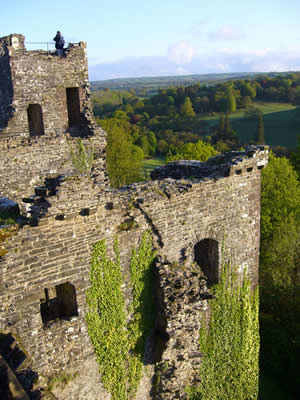
Whereas Llandeilo was an important ecclesiastical centre, neighbouring Llandyfeisant was most politically important by virtue of its castle, standing on a massive limestone crag overlooking the river which was, for part of its history, the centre of government for much of Wales. In such a commanding position it could well have been a fortified site from very far-off times. It is recorded in the Chronicles that Rhodri Mawr, coming down from the north, established his seat there and was effectively ruler of Wales. His grandson, Hywel Dda, the law-giver, ruler of Deheubarth (south-west Wales) and later, Gwynedd and possibly Powys, had his principal Llys (court) at Dinefwr. Coinage of 950 showed him enthroned as head of state over Wessex and Wales. The “Brut” calls him “head and glory of all the Britons”. One provision of these laws was that a tribute of white cattle with black markings must be paid for any personal injury to the king of Deheubarth. Their descendents, the White Park cattle, graze the estate to this day.
1155 saw the reign of the great Rhys ap Gruffydd who became generally known as the highly respected “The Lord Rhys” who, in 1172, after standing alone politically against Henry II was created by him Justiciar of South Wales. It was the Lord Rhys who called the first National Eisteddfod to his castle in Cardigan in 1176. It was also he or his son Rhys Crug who created the first stone fortifications and their massive round keep, which remains decorated with a narrow frieze of Bath stone, stands proudly to this day, Although later falling to the English who added further buildings, Castell Dinefwr can well be said to be the best truly Welsh castle remaining to this day- as distinct form such as Caernarfon or Conway, built by the English for the suppression of Wales.
As the years rolled by though, and the county became more peaceful, the family in the castle obviously felt they could leave this windy site and move down to a more sheltered position, They had a house built around which a new English borough arose, the borough of Newton, which though comparatively short-lived, gave its name to Newton House which stands there now. The name of the house was altered for many years to the much grander “Dynevor Castle” the seat of Barons Dynevor, with the ancient edifice they had vacated being known as “The Old Castle”.
Though sheltered and doubtless much more comfortable, the magnificent views from the old castle must have been missed so a summer house, sadly now without its one-time conical roof, stands atop that keep to this day.
The last of the family to live in Newton House was Richard Rhys, ninth Baron Dynevor, who sadly passed away in 2008. The house and much of what was left of the park was sold into private hands about 1980 until it was eventually bought by the National Trust, who now manage the house and much of the estate, including the White Park cattle. The old castle though had been bought in 1979 by the West Wales Naturalists Trust (now the Wildlife Trust of South and West Wales). The Wildlife Trust then arranged a Deed of Guardianship with Cadw, who took on the restoration of the ruin. After many years of painstaking work it was declared open to everyone, every day of the year, in June 1998.
It is strange though for a nature conservation charity to have an ancient castle. It has happened that when the late Lord Dynevor’s father died in 1962, he found himself owing death duties from both father and grandfather, who had died only six years previously. He was forced to sell most of his property to meet that tax and with land not being in great demand at the time, sold most of the park to a land-holding company who later sold it on in separate lots. The 61 acres of ancient deciduous woodland known as Castle Woods became the property of a forestry company in Buckinghamshire, who were expected to clearfell it and plant with conifers as a tax break for investors.
Learning of this, Mr Ian Watt, a Scottish forester who had come to live in Llandeilo, immediately set about raising funds to buy the woods as a nature reserve. In 1979 these 61 acres was bought by the then West Wales Naturalists Trust. Standing proudly in the western end of the reserve, though, was the ancient castle, surrounded by the woodland, so of course that was part of the transaction as well.
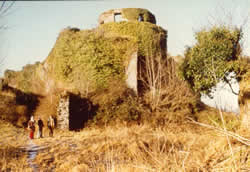
There was an ivy-covered ruin and it was Mr Watt, knowing well of its eminent place in the history of Wales, who was foremost in getting that restoration started. Gwynfor Evans, when he was member of Parliament for Carmarthen, asked the Minster of Works in the House many years before to undertake its rescue but was told that as there was no public access at that time, much as his ministry wished to do so, restoration could not be undertaken.
The now well-restored castle can therefore be said to be a memorial to Mr Watt’s vision.
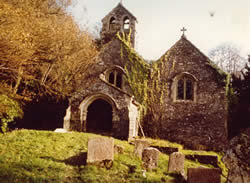
Also within the woodland though, on a site still owned by the Church in Wales, stands a charming little Church. With a long history of decay and rebuilding it was finally left to go to ruin but was repaired by the Wildlife Trust on a lease from the Church in Wales and was for many years a prestigious visitor centre, visited by people from all over the world. In such a beautiful spot, with a never-failing stream running by, it is easy to see how Tyfei could have been drawn to the place. Recent excavations have shown Roman forts in the park and Ordnance Survey maps show a Roman coin-hoard having been found around 1800 in the field below the church. Moreover, it is said that workmen in the graveyard close to the south wall of the church had uncovered Roman stonework. The 1905 revision of the 6 inch map shows, quite positively, “ROMAN TEMPLE (site of)”. It could well be that it was so. In that case, as religious sites tend to perpetuate, it might have been a Druidic site beforehand. Can there be many more historical parishes of such diversity than Llandyfeisant?
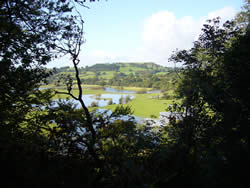
The woodlands around Dinefwr Castle and Llandyfeisant Church are now managed for wildlife by the Wildlife Trust of South and West Wales. Like the castle itself, access to these woods is open to everyone at all times and free of charge. They are broadleaved woodlands, with oak, ash, beech and sycamore the commonest trees. Elm was common until Dutch elm disease struck in the 1970s, drastically reducing the number of elm trees, especially around the castle, but the species is now recovering. They are ancient woodlands, and contain a large number of ‘veteran trees’, which are extremely large and old. They themselves are home to a wide variety of other wildlife, such as lichens and ferns. Birds such as nuthatches, woodpeckers and treecreepers are common, and summer visitors include willow warblers, chiffchaffs, redstarts and pied flycatchers. In the winter, woodcock use the woodlands.
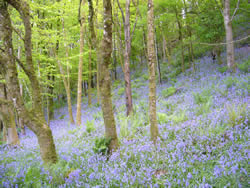
The woodland flowers are at their best in the early summer, when large areas of the woods are carpeted with sweet-smelling bluebells, and other spring beauties such as wild garlic, dog’s mercury, lesser celandine, wood sorrel and wood anemone. Wild fallow deer also roam through the wooded ridges.
For more information on visiting see the Wildlife Trust of South and West Wales reserve of Castle Woods or contact the reserve manager, Lizzie Wilberforce